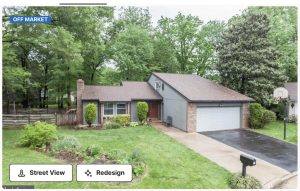This is another chapter in the Before Time series of articles (here’s the last one) written by those who experienced those times for the sake of the edification of those who are too young to have experienced them and so have no knowledge of how things were, once.
My parents bought their first house in 1969 – in Stamford, CT. It was a split level in a nice suburban neighborhood, sitting on about a half-acre of land. They paid about $33,000 for it, equivalent in today’s devalued currency to about $300,000. I decided to check what the old house would cost today.
First, though, how about what it costs to not be evicted from it, today.
According to the latest public records data I could find, the annual property tax on the old house is currently $10,530. In other words, three years of property taxes on the old house in our time amounts to as much as my parents paid for the house back in the Before Time of 1969. In inflated-equivalent currency, it would come to about $2k per year, if my parents had been obliged to pay this rent (on top of their mortgage) with 1969 money. In five years’ time, they’d have had to pay a third again in rent – which is what “property taxes’ amount to – than they paid for the house.
As in the whole thing.
But they didn’t have to pay that much because it was 1969 – the Before Time – and both the taxes on the house and the house were affordable in those times.
Neither are today.
You have just read about the taxes on the house. How about the cost of house, itself? In these times, that is.
According to the latest Redfin estimate, the old house would list for $1.3 million if it were put on the market today. If that’s how much the house cost in 1969, my parents would have had to come up with about $150,000 in 1969 dollars, a or somewhere in between four and fives time as much as they had to come up with when they actually bought the house in ’69.
Which they were able to do because the house didn’t cost 4-5 times as much then as it does now.
Fast forward about 27 years to the time when I bought my first house, in the suburbs of Washington, DC.
It was possible for me to buy a house because it was still possible at the time – the 1990s – to buy a small house in the DC suburbs for around $170,000 or so. More finely, because it was possible for a young person to save up the 10 percent down payment that’s generally necessary to qualify for a home loan. In my case, this amounted to about $17,000. Not a small sum but also not an impossible sum. Save about $2,500 per year for about six years and you had enough to put down on the $170k house and that’s exactly what I did.
Because I could.
I looked up my first house on Redfin and discovered that if it were to be put on the market today, the asking price would be in the vicinity of $630k. That is an increase (unadjusted for devaluation) of $460k – nearly half a milion dollars – over about 28 years. Adjusted, it is a real-money (well, buying power of money) difference of about $300k, now vs. then.
Ten percent down today would mean $63,000 – an all-but-impossible sum for anyone who isn’t already the owner of a home (who can tap the inflated equity of their home to swing the down payment on a new home) to come up with on their own. It would take saving $10k for six years or $5k for 20, by which time a person in their 20s would be well into their 40s.
And then you’d have to pay the mortgage on a $630k first house. Plus the rent styled “property taxes.”
Mind, my first house was similar to my parents’ first house in that both houses were ordinary houses on small lots in what were then middle and working class subdivisions. But that was back when the middle and working class could afford to live in single family homes.
Who lives in my parents’ old house, today? Millionaires. Ipso facto. They are the only people who can afford to live in my parents’ old house, which conveys some sense of the devaluation of being a “millionaire” today.
Similarly, my old house. Whoever is living in it today is nearly a millionaire – at least on paper. What did they get for what they spent? A house built in 1971 that cost a third what my parents’ paid for theirs in ’69 because it wasn’t as nice a house. It had single pane windows and shag carpet and T-111 siding. But it was a great first house and I was grateful to be the owner of it.
Today – 20 years after I sold it – I could not afford to buy it again.
And I’m no longer a young guy in his 20s. So I have great sympathy for those who are in their 20s today, who look at the cost of a nothing-special average house – now around $400,000 – and have resigned themselves to never owning a house. But it’s important for them to understand it’s not the cost of houses that has gone ballistic so much as it is the cost of speculation in housing, which is now regarded as an investment – something to be flipped and cashed-out (rinse and repeat) rather than a place to live.
The mania began in earnest shortly after I bought my old house, thanks to the intercessions of The Chimp who also turned what used to be American into a “homeland” and flying commercial into Obedience Training.
Instead of saving up 10 percent, people who had zero percent (some with no income, either) were issued loans, which they assumed because they figured they could flip/cash out (and so, make out) before anyone figured it out.
This caused a speculative bubble that never truly popped. It just got a little smaller, for a little while. It is now bigger again – and likely to get even bigger, if Kamala Harris becomes the new “Decider.” Her promise to gift new home buyers $25k won’t make homes more affordable. It will increase what people are expected to pay for them, as sellers jack up their prices to cash in on the the new and easy money.
People in their 20s today have no memory of what it was like before all of this – which is the purpose of this remembrance. My first house may not have had granite countertops or triple pane Andersen windows. But it was my house – and I feel a sadness for the 20-somethings of today who will never know how that feels.
https://www.ericpetersautos.com/2024/09/17/before-time-home-costs/
If you like what you’ve found here please consider supporting EPautos.
We depend on you to keep the wheels turning!
Our donate button is here.
If you prefer not to use PayPal, our mailing address is:
EPautos
721 Hummingbird Lane SE
Copper Hill, VA 24079